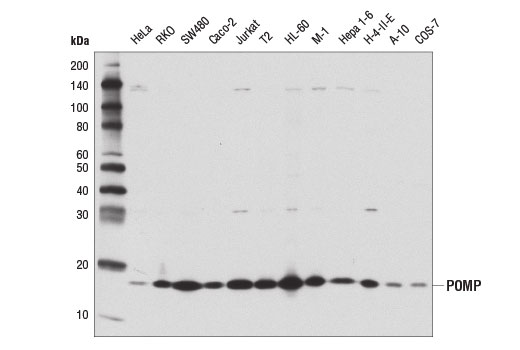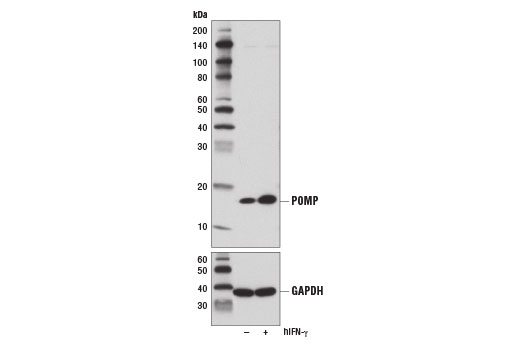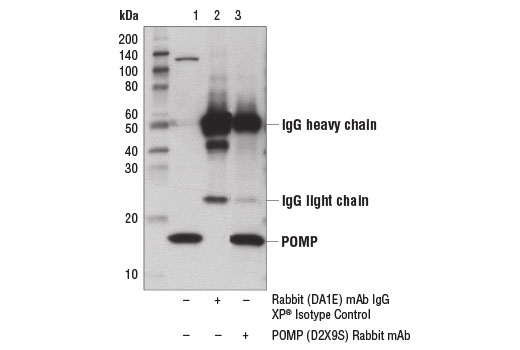WB, IP
H M R Mk
Endogenous
16
Rabbit IgG
#Q9Y244
51371
Product Information
Product Usage Information
| Application | Dilution |
|---|---|
| Western Blotting | 1:1000 |
| Immunoprecipitation | 1:200 |
Storage
Specificity / Sensitivity
Species Reactivity:
Human, Mouse, Rat, Monkey
Species predicted to react based on 100% sequence homology
The antigen sequence used to produce this antibody shares
100% sequence homology with the species listed here, but
reactivity has not been tested or confirmed to work by CST.
Use of this product with these species is not covered under
our
Product Performance Guarantee.
Bovine
Source / Purification
Monoclonal antibody is produced by immunizing animals with a synthetic peptide corresponding to residues near the amino terminus of human POMP protein.
Background
The 26S proteasome is a highly abundant proteolytic complex involved in the degradation of ubiquitinated substrate proteins. It consists largely of the 20S catalytic core particle (CP) and the 19S/PA700 regulatory particle (RP) that caps either end of the CP. The CP consists of two stacked heteroheptameric β-rings (β1-7) that contain three catalytic β-subunits flanked on either side by two heteroheptameric α-rings (α1-7). The RP includes multimeric base and lid complexes. The RP base includes a heterohexameric ring of ATPase subunits that unfold the substrate and open the α-subunit gate to expose the substrate to the catalytic β-subunits. The lid consists of ubiquitin receptors and DUBs that recruit ubiquitinated substrates and modify ubiquitin chain topology (1,2). Proteasome activity modulators, such as PA28/11S REG, bind the 20S CP cylinder end and open the CP channel (1,2).
Proteasome maturation protein (POMP, proteassemblin, hUMP1) is an integral factor essential for assembly of the 20S catalytic core particle during mammalian proteasome biogenesis. POMP promotes heteroheptameric β-ring formation and dimerization of half-proteasomes during core particle assembly. The POMP protein undergoes proteasomal degradation following 20S CP complex assembly and activation (3-6). Research studies suggest that POMP is required for CP assembly for both constitutive proteasomes and immunoproteasomes, and that the assembly focal point resides at the endoplasmic reticulum (6-8). A single nucleotide deletion in the 5' UTR of POMP results in altered epidermal POMP distribution and the autosomal recessive skin disorder known as KLICK syndrome (9).
- Finley, D. (2009) Annu Rev Biochem 78, 477-513.
- Lee, M.J. et al. (2011) Mol Cell Proteomics 10, R110.003871.
- Griffin, T.A. et al. (2000) Mol Cell Biol Res Commun 3, 212-7.
- Witt, E. et al. (2000) J Mol Biol 301, 1-9.
- Ramos, P.C. et al. (1998) Cell 92, 489-99.
- Fricke, B. et al. (2007) EMBO Rep 8, 1170-5.
- Heink, S. et al. (2005) Proc Natl Acad Sci U S A 102, 9241-6.
- Heink, S. et al. (2006) Cancer Res 66, 649-52.
- Dahlqvist, J. et al. (2010) Am J Hum Genet 86, 596-603.
Species Reactivity
Species reactivity is determined by testing in at least one approved application (e.g., western blot).
Western Blot Buffer
IMPORTANT: For western blots, incubate membrane with diluted primary antibody in 5% w/v BSA, 1X TBS, 0.1% Tween® 20 at 4°C with gentle shaking, overnight.
Applications Key
WB: Western Blotting IP: Immunoprecipitation
Cross-Reactivity Key
H: human M: mouse R: rat Hm: hamster Mk: monkey Vir: virus Mi: mink C: chicken Dm: D. melanogaster X: Xenopus Z: zebrafish B: bovine Dg: dog Pg: pig Sc: S. cerevisiae Ce: C. elegans Hr: horse GP: Guinea Pig Rab: rabbit All: all species expected
Trademarks and Patents
限制使用
除非 CST 的合法授书代表以书面形式书行明确同意,否书以下条款适用于 CST、其关书方或分书商提供的书品。 任何书充本条款或与本条款不同的客书条款和条件,除非书 CST 的合法授书代表以书面形式书独接受, 否书均被拒书,并且无效。
专品专有“专供研究使用”的专专或专似的专专声明, 且未专得美国食品和专品管理局或其他外国或国内专管机专专专任何用途的批准、准专或专可。客专不得将任何专品用于任何专断或治专目的, 或以任何不符合专专声明的方式使用专品。CST 专售或专可的专品提供专作专最专用专的客专,且专用于研专用途。将专品用于专断、专防或治专目的, 或专专售(专独或作专专成)或其他商专目的而专专专品,均需要 CST 的专独专可。客专:(a) 不得专独或与其他材料专合向任何第三方出售、专可、 出借、捐专或以其他方式专专或提供任何专品,或使用专品制造任何商专专品,(b) 不得复制、修改、逆向工程、反专专、 反专专专品或以其他方式专专专专专品的基专专专或技专,或使用专品开专任何与 CST 的专品或服专专争的专品或服专, (c) 不得更改或专除专品上的任何商专、商品名称、徽专、专利或版专声明或专专,(d) 只能根据 CST 的专品专售条款和任何适用文档使用专品, (e) 专遵守客专与专品一起使用的任何第三方专品或服专的任何专可、服专条款或专似专专


